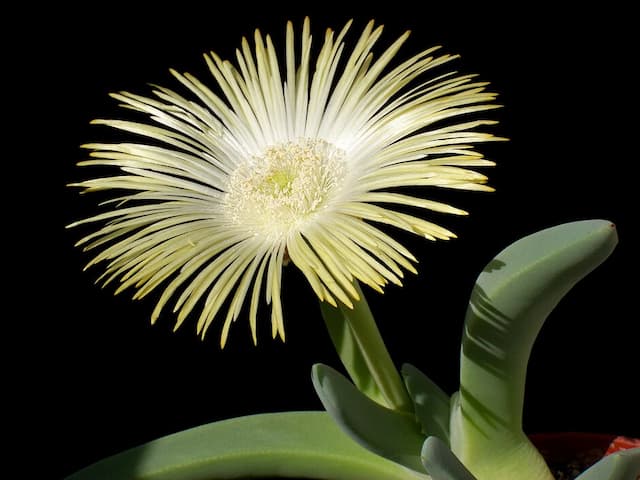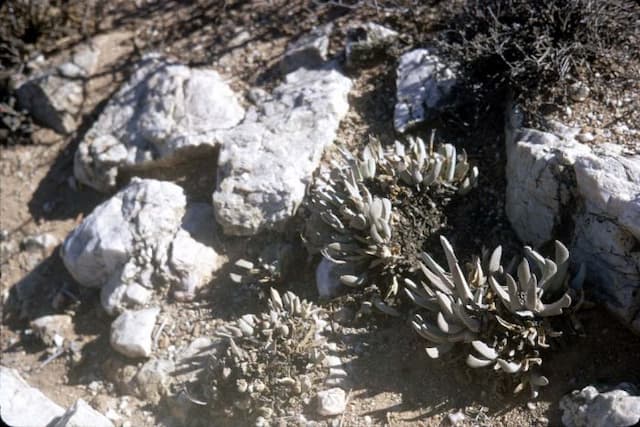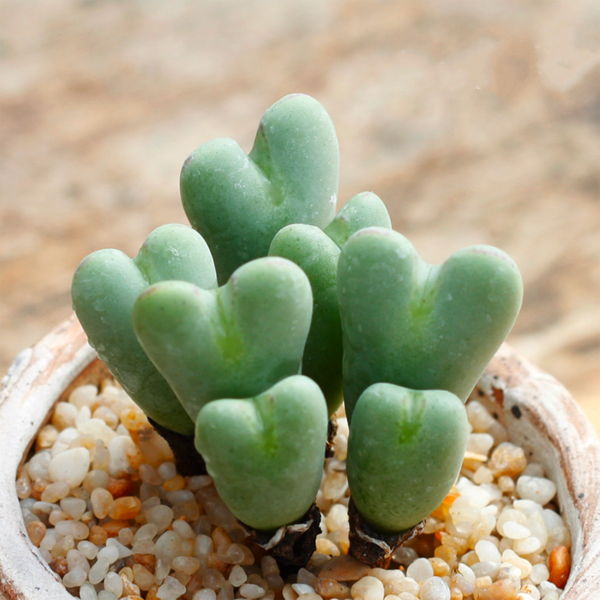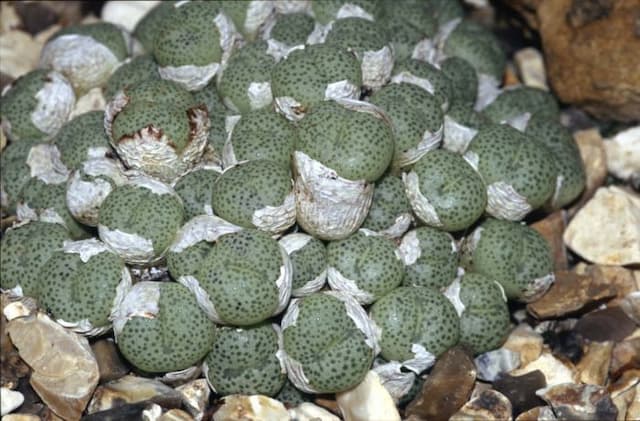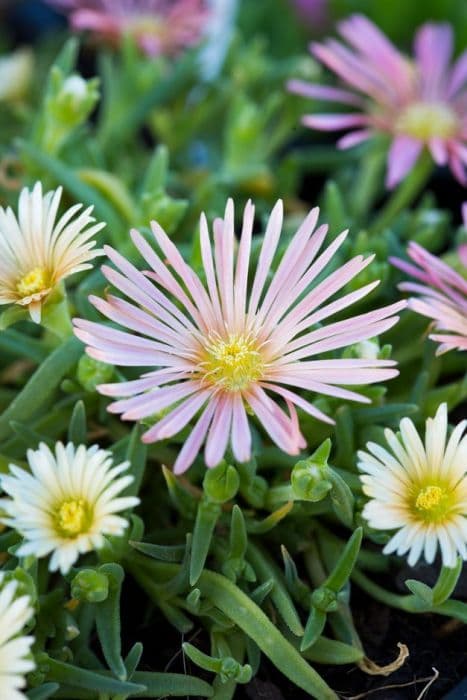Brown's Middag-Blommetjie Lampranthus brownii

ABOUT
Lampranthus brownii, commonly known as the Brown's Lampranthus, is an attractive succulent plant. It boasts a sprawling, spread-out form with plump, fleshy leaves that are often green to blue-green in color. Characteristic of many succulents, these leaves are thick, designed to retain moisture, and typically have a somewhat triangular or angular shape. The plant is known for its vibrant and showy daisy-like flowers that come in a variety of hues such as bright pinks, purples, or sometimes yellows, with a multitude of long, slender petals radiating from a central disc. These blooms typically appear in clusters, creating a carpet of color when the plant is viewed from above. The overall appearance of the Brown's Lampranthus is one of dense foliage accompanied by a seasonal profusion of eye-catching flowers that draws attention, particularly when in full bloom.
About this plant
 Names
NamesFamily
Aizoaceae
Synonyms
Brown's Ice Plant, Trailing Ice Plant
Common names
Mesembryanthemum brownii.
 Toxicity
ToxicityTo humans
The Lampranthus brownii, commonly known as the Brownii Ice Plant, is not listed as a toxic plant to humans. Therefore, it should not cause harm if ingested. However, as with any non-food plant, individual allergies or sensitivities may occur, so it's advisable to avoid eating the plant. If someone does ingest Brownii Ice Plant and experiences any adverse effects, it would be appropriate to consult a healthcare provider.
To pets
The Brownii Ice Plant, which is the common name for Lampranthus brownii, is not listed as a toxic plant for pets. This includes common household pets such as dogs and cats. Consumption of this plant should not result in poisoning or severe adverse effects. However, ingestion of non-food plants can sometimes lead to mild gastrointestinal upset in pets, so it is still recommended to prevent pets from eating this plant. If a pet ingests the plant and shows signs of illness, consulting a veterinarian is advised.
 Characteristics
CharacteristicsLife cycle
Perennials
Foliage type
Evergreen
Color of leaves
Green
Flower color
Pink
Height
6 inches (15 cm)
Spread
2 feet (60 cm)
Plant type
Succulent
Hardiness zones
9
Native area
South Africa
Benefits
 General Benefits
General Benefits- Low Maintenance: Lampranthus brownii, commonly known as Brown's Lampranthus, is a hardy plant that requires minimal care once established, making it ideal for low-maintenance gardens.
- Drought Tolerance: It is highly tolerant to drought conditions, due to its succulent nature, which allows it to thrive in arid environments with little water.
- Erosion Control: Brown's Lampranthus can help prevent soil erosion thanks to its mat-forming growth habit, which helps to stabilize the soil on slopes and banks.
- Attracts Pollinators: The plant's vibrant flowers attract a variety of pollinators, including bees and butterflies, which are essential for the pollination of many plants and crops.
- Aesthetic Appeal: With its bright flowers that bloom prolifically during the growing season, Brown's Lampranthus adds a splash of color to rock gardens, borders, and ground cover areas.
- Versatile Planting: It can be grown in containers or hanging baskets, making it versatile for various landscaping designs and suitable for those with limited space.
- Fast Growth: Brown's Lampranthus grows quickly, which can be advantageous for gardeners looking to establish ground cover or fill in empty spaces in a short time frame.
 Medical Properties
Medical PropertiesThis plant is not used for medical purposes.
 Air-purifying Qualities
Air-purifying QualitiesThis plant is not specifically known for air purifying qualities.
 Other Uses
Other Uses- Lampranthus brownii, commonly known as Brown's Lampranthus, can be used as a natural dye source for fabrics, providing a range of earthy tones depending on the mordant used.
- The plant's succulent leaves can be crushed and mixed into a paste to be used as a natural adhesive or sealant for small crafts projects.
- Dried and powdered leaves of Brown's Lampranthus can serve as a component in homemade potpourri mixes, offering a subtle, fresh fragrance.
- The plant can be employed in xeriscaping, a landscaping technique that reduces or eliminates the need for irrigation, due to its drought tolerance.
- As an edging plant, Brown's Lampranthus can be used to create clear boundaries in garden designs without the need for physical barriers.
- The plant's trailing habit makes it suitable for creating living mulch, which suppresses weeds and retains soil moisture.
- The succulent's vibrant flowers can be pressed and used in decorative botanical art and craft projects like handmade cards or bookmarks.
- Gardeners might use cuttings of Brown's Lampranthus to create living roofs or green coverings on small outdoor structures for aesthetic appeal.
- The plant is sometimes utilized in sensory gardens, where its fleshy leaves provide a unique tactile experience for visitors.
- Its ability to grow in coastal areas where other plants might not thrive makes Brown's Lampranthus a valuable plant for erosion control on sandy soils.
Interesting Facts
 Feng Shui
Feng ShuiThe Ice Plant is not used in Feng Shui practice.
 Zodiac Sign Compitability
Zodiac Sign CompitabilityThe Ice Plant is not used in astrology practice.
 Plant Symbolism
Plant Symbolism- Resilience: Lampranthus brownii, commonly known as the 'Ice Plant,' often symbolizes resilience due to its ability to thrive in dry, arid environments, representing the ability to endure and overcome difficult conditions.
- Beauty: The Ice Plant's vibrant flowers represent beauty and visual appeal, often reflecting the idea that beauty can be found even in harsh or challenging circumstances.
- Adaptation: As a plant that adapts well to its surroundings, the Ice Plant can symbolize the importance of flexibility and the ability to adjust to new situations.
- Bounty: With its abundant and colorful blooms, the Ice Plant symbolizes bounty and generosity, suggesting a plentifulness in life or spirit.
- Survival: The hardy nature of the Ice Plant makes it a symbol of survival, indicative of the tenacity required to survive and even prosper no matter the obstacles faced.
 Water
WaterFor a Brown-eyed Ice Plant, water thoroughly but infrequently, ensuring the soil completely dries out between waterings to imitate its natural arid habitat. During active growing seasons such as spring and summer, watering once every week with about half a gallon for potted plants or a slow, deep watering for garden plants is sufficient. Reduce to once every two to three weeks in colder seasons. Always check the top couple of inches of soil for dryness before the next watering to prevent overwatering and root rot.
 Light
LightThe Brown-eyed Ice Plant thrives best in full sun which means it should receive at least six hours of direct sunlight daily. A south-facing window or a spot in your garden that gets unobstructed sunlight is ideal. Adequate sun exposure is crucial for robust growth and vibrant blooms.
 Temperature
TemperatureThe ideal temperature range for Brown-eyed Ice Plant is between 40°F and 80°F. It can withstand short periods of colder temperatures down to about 30°F, but it should not be subjected to frost. During the hot summer months, the plant can tolerate highs up to 100°F as long as it is well-watered and has sufficient airflow.
 Pruning
PruningPrune the Brown-eyed Ice Plant to shape it and remove dead or damaged stems, which will encourage new growth and more prolific blooming. The best time to prune is in early spring before new growth begins. Pruning once a year is typically adequate for maintaining a healthy plant.
 Cleaning
CleaningAs needed
 Soil
SoilThe best soil mix for the Brownii Ice Plant is a well-draining cactus or succulent mix with added perlite or coarse sand to ensure excellent drainage. The soil pH ideal for this plant is slightly acidic to neutral, ranging between 6.0 and 7.5.
 Repotting
RepottingBrownii Ice Plant should be repotted every 2 to 3 years or when it outgrows its current container. This allows for the replacement of old soil and encourages continued growth.
 Humidity & Misting
Humidity & MistingBrownii Ice Plant prefers a dry climate and does not require high humidity levels. It thrives in typical indoor humidity levels and should be kept in a well-ventilated area to prevent moisture accumulation.
 Suitable locations
Suitable locationsIndoor
Place in a sunny spot, minimize watering, well-draining pot.
Outdoor
Use well-draining soil, full sun, protect from frost.
Hardiness zone
9-11 USDA.
 Life cycle
Life cycleLampranthus brownii, commonly known as Brown's Chandelier Plant, germinates from seed in favorable conditions, typically in well-draining, sandy soil and full sun exposure. The seedlings emerge with succulent foliage and establish a root system, adapting to arid environments with minimal water requirements. As the young plants grow, they develop fleshy leaves and a sprawling habit, maturing over several months to years. The mature plant produces vibrant daisy-like flowers, usually in the colors of purple, pink, or occasionally yellow, that bloom primarily in spring to early summer. After pollination, often by insects attracted to the flowers, the plant sets seed contained within small capsules that, once dried, release the seeds to propagate the next generation. Over time, older plants may become woody at the base, and without proper care, they can succumb to rot or pests, but with optimal conditions, they are perennial and can live for many years.
 Propogation
PropogationPropogation time
Spring-Early Summer
The most popular method for propagating Lampranthus brownii, commonly known as Brown’s Ice Plant, is through stem cuttings. This method is ideally done in late spring to early summer when the plant is actively growing. A healthy, non-flowering stem is chosen and a cutting of about 4-6 inches (10-15 cm) is snipped with a clean, sharp tool. The cut end of the stem is allowed to callous over for a few days in a dry, warm place to prevent rot. After the cut end has dried, the cutting is placed in well-draining soil mix, watering sparingly until roots have established. An indication of successful propagation will be new growth at the tip of the cutting, which may be observed in a few weeks depending on the conditions.
